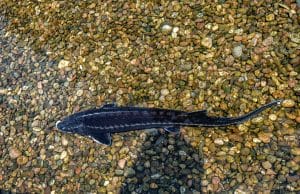
What Are Pond Skimmers And How Do You Choose The Right One? Essential Guide for Clear Water Maintenance
Pond skimmers are essential devices for keeping water features clean and healthy. These tools remove debris from the surface of ponds and water gardens, preventing it from sinking and causing problems. A pond skimmer works by drawing water across the surface, trapping floating leaves, twigs, and other bits in a basket or net.

Choosing the right pond skimmer can be tricky. It’s important to consider the size of your pond, the type of debris you’re dealing with, and your budget. Some skimmers are designed for small garden ponds, while others can handle large koi ponds or commercial water features.
Proper skimmer selection and installation can make a big difference in pond maintenance. A good skimmer will save time on cleaning and help keep your pond looking its best. It can also improve water quality by removing organic matter before it breaks down.
Key Takeaways
- Pond skimmers remove surface debris to keep water clean
- Skimmer choice depends on pond size and debris type
- Proper skimmer use reduces maintenance and improves water quality
Understanding Pond Skimmers
Pond skimmers are essential tools for keeping ponds clean and healthy. They remove debris from the water’s surface, preventing it from sinking and decaying.
Fundamentals of Skimmers
Pond skimmers work by drawing water from the surface into a collection basket. They use the pond’s natural water flow to trap floating debris like leaves, twigs, and insects. Most skimmers have a pump that creates this water movement.
Skimmers come in different sizes to suit various pond volumes. They often include filters to catch smaller particles. Regular cleaning of the skimmer basket is crucial for proper function.
Some skimmers have built-in features like UV lights to control algae growth. Others may include pre-filters to ease maintenance.
Types of Pond Skimmers
There are two main types of pond skimmers: floating and in-pond skimmers.
Floating skimmers move freely on the water’s surface. They’re easy to install and work well in ponds with changing water levels. These skimmers are ideal for smaller ponds or those with irregular shapes.
In-pond skimmers, also called pond skimmer boxes, are fixed at the pond’s edge. They’re more powerful and can handle larger ponds. These skimmers often connect to the pond’s main filtration system.
Surface skimmers are a subset of in-pond skimmers. They sit just below the water line and are less visible.
Benefits of Installing a Pond Skimmer

Pond skimmers offer several key advantages for pond owners. They help maintain clean water, reduce maintenance tasks, and enhance the overall appearance of a water feature.
Water Quality Improvement
Pond skimmers play a crucial role in keeping water clean and healthy. They remove floating debris like leaves, twigs, and other organic matter before it sinks and decays. This process helps prevent excess nutrients from building up in the water.
Skimmers also aid in oxygenating the water by creating surface movement. This increased oxygen levels support beneficial bacteria that break down waste. As a result, pond owners can expect clearer water and healthier fish.
Many skimmers include filter media that trap smaller particles. This extra filtration step further improves water quality by removing tiny bits of debris and algae.
Reduction in Maintenance Efforts
A well-designed skimmer can greatly reduce the time and effort needed to maintain a pond. By constantly removing surface debris, skimmers prevent this material from sinking and forming sludge at the bottom of the pond.
This means less frequent cleaning is needed to remove built-up muck. Pond owners can spend less time raking leaves and more time enjoying their water feature.
Skimmers also help protect pond pumps by catching debris before it can clog the system. This leads to fewer pump issues and less need for repairs or replacements.
Enhancing the Aesthetic Appeal
Skimmers contribute to a more natural and attractive pond appearance. By keeping the water surface clear of floating debris, they create a pristine look that mimics a natural body of water.
Many skimmers are designed to be hidden from view, preserving the natural look of the pond’s edges. This allows for a seamless blend between the water and surrounding landscape.
The improved water quality resulting from a skimmer’s work also leads to better clarity. This enhanced visibility allows pond owners and visitors to better appreciate fish, plants, and other underwater features.
Key Features to Consider

Selecting the right pond skimmer involves evaluating several crucial aspects. These factors ensure optimal performance and maintenance of your pond ecosystem.
Correct Sizing for Your Pond
Choosing a skimmer that matches your pond size is vital. A skimmer that’s too small won’t clean effectively, while one that’s too large wastes energy. Most manufacturers list recommended pond sizes for their skimmers.
For smaller ponds under 1,000 gallons, a compact skimmer suffices. Medium-sized ponds between 1,000 and 5,000 gallons need mid-range models. Large ponds over 5,000 gallons require heavy-duty skimmers with higher capacities.
Always measure your pond’s surface area and volume accurately before selecting a skimmer. This ensures you get the right fit for your water feature.
Flow Rate and Water Circulation
Flow rate is a key factor in skimmer performance. It determines how quickly water moves through the system and how effectively it removes debris.
A good rule of thumb is to choose a skimmer that can process your pond’s entire volume every 1-2 hours. For example, a 2,000-gallon pond needs a skimmer with a flow rate of at least 1,000-2,000 gallons per hour.
Higher flow rates improve water circulation, which is crucial for pond health. Good circulation reduces stagnant areas and helps distribute oxygen throughout the water.
Weir Door and Mechanical Filtration
The weir door is the entry point for water and floating debris. A well-designed weir door should adjust to water level changes, ensuring consistent skimming.
Look for skimmers with sturdy, corrosion-resistant weir doors. Some models offer adjustable weir doors, allowing you to fine-tune performance.
Mechanical filtration is typically handled by filter pads or brushes inside the skimmer. These catch smaller particles that pass through the weir door.
High-quality filter media is essential for effective debris removal. Some skimmers use multi-stage filtration for better results.
Ease of Cleaning
Regular cleaning is necessary for skimmer maintenance. Choose a model that’s easy to access and clean.
Look for skimmers with removable debris baskets. These make it simple to empty collected leaves and twigs.
Easily replaceable filter pads are another plus. Some skimmers have tool-free designs for quick pad changes.
Consider models with clear lids or inspection windows. These let you check debris levels without opening the entire unit.
Pre-filtration features like leaf traps can reduce cleaning frequency. They catch larger debris before it reaches the main filter, extending time between cleanings.
Integration with Other Pond Components
Pond skimmers work together with other equipment and elements to create a balanced aquatic ecosystem. Proper integration ensures optimal water quality and pond health.
Pump and Filter Compatibility
Skimmers must match the flow rate of pond pumps for effective operation. A skimmer’s capacity should handle the pump’s output to prevent overflow or inadequate skimming. Many skimmers have built-in pump chambers, simplifying installation and maintenance.
Filters often connect directly to skimmers, creating a streamlined system. Some models combine skimming and filtration in one unit. This setup saves space and reduces plumbing needs.
When choosing a skimmer, consider your existing pump and filter specifications. Look for models that offer easy connections and complementary flow rates.
Working with UV Clarifiers
UV clarifiers help control algae growth in ponds. These devices can be integrated with skimmer systems for added water clarity. Some skimmers come with built-in UV clarifiers, offering a compact solution.
When using separate units, place the UV clarifier after the skimmer in the water flow. This ensures debris is removed before water passes through the clarifier.
UV clarifiers work best in conjunction with proper filtration and skimming. The combination of these systems provides comprehensive water treatment.
Aesthetics and Plant Life
Skimmers can be hidden to maintain a natural pond appearance. Many models are designed to blend in with surroundings or be partially buried. This allows for efficient water circulation without disrupting the pond’s visual appeal.
Consider the placement of aquatic plants when installing a skimmer. Avoid positioning it where plants may interfere with water flow. Some skimmers feature plant shelves or baskets, allowing for integration of greenery around the unit.
Floating plants can complement skimmer function by providing additional surface coverage. This helps reduce debris entering the pond and limits algae growth.
Installation and Maintenance Tips
Proper setup and care of your pond skimmer is crucial for keeping your water feature clean and healthy. Regular upkeep and quick troubleshooting help ensure optimal performance.
Setting Up Your Pond Skimmer
Choose a spot near the pond’s edge for your skimmer. Dig a hole slightly larger than the skimmer box. Place the skimmer so its opening sits just above the water line. Connect the skimmer to your pump and filtration system using flexible tubing.
Ensure a snug fit around the skimmer’s faceplate to prevent leaks. Use expanding foam to seal any gaps. Add rocks or plants around the skimmer to blend it into the landscape.
Check that the water level reaches the middle of the skimmer opening for best results. Too high or low can reduce efficiency.
Regular Cleaning and Upkeep
Empty the debris basket weekly or when it’s half full. Remove leaves, twigs, and other waste. Rinse the basket thoroughly before replacing it.
Clean the filter mats monthly. Remove them from the skimmer and hose off any built-up gunk. Replace filters annually or when they start to break down.
Check the pump and connections for any blockages or wear. Clear any debris from the impeller to maintain powerful suction.
In winter, remove the pump and store it indoors to prevent freezing damage. Cover the skimmer or add a de-icer for year-round use.
Troubleshooting Common Issues
If the skimmer isn’t collecting debris, check the water level. Adjust if needed to ensure proper flow. Inspect the pump for clogs or damage.
Low suction might mean it’s time to clean the filters or debris net. A blocked impeller can also reduce performance.
Strange noises often indicate something is stuck in the pump. Turn it off and remove any foreign objects.
Leaks around the faceplate may require resealing. Drain the area and apply fresh sealant to create a watertight barrier.
Safety and Environmental Considerations
Pond skimmers play a vital role in maintaining a healthy aquatic ecosystem. They help protect fish, manage waste, and keep the water clean. Proper use of skimmers is key to a thriving pond environment.
Ensuring Fish and Wildlife Safety
Skimmers must have safety features to protect fish and small animals. Screens or guards on intake ports stop creatures from being sucked in. Low-flow settings reduce the risk of trapping wildlife. Some models have fish-friendly pumps that won’t harm scales or fins.
Regular checks are crucial. Look for signs of stressed fish near the skimmer. Clean screens often to prevent clogs that could harm pond life. In winter, adjust the skimmer to avoid freezing, which can hurt fish. Choose skimmers with adjustable flow rates to suit different seasons and pond sizes.
Handling Organic and Inorganic Waste
Skimmers collect both plant matter and man-made rubbish. They trap leaves, twigs, and algae before they sink and rot. This helps control ammonia levels, which can be harmful to fish. Many skimmers have removable baskets for easy cleaning.
It’s important to empty skimmer baskets regularly. This stops waste from breaking down in the water. Some advanced models can separate organic from inorganic waste. Organic matter can be composted, while inorganic items should be disposed of properly.
Skimmers also help manage surface debris like pollen and dust. This improves water clarity and reduces algae growth. For best results, pair a skimmer with a biological filter to maintain pond health.
Choosing the Best Pond Skimmer
Selecting the right pond skimmer is crucial for keeping your water garden clean and healthy. The best choice depends on your pond size, budget, and specific needs.
Top Rated Skimmers on the Market
Several top-rated skimmers stand out for pond owners. The Aquascape Signature Series 1000 is popular for small to medium ponds. It has a large debris basket and can handle ponds up to 1,000 gallons. For larger koi ponds, the Savio Compact Skimmerfilter is a solid pick. It offers strong filtration and can manage ponds up to 2,000 gallons.
The Laguna PowerFlo Filter System is another top choice. It combines a skimmer and biological filter, making it ideal for garden ponds that need extra cleaning power. For those with bigger budgets, the Evolution Aqua Nexus Eazy Pod is a high-end option. It uses advanced K1 media for superior filtration.
Budget Considerations for Buyers
Pond skimmers come in a range of prices to fit different budgets. Basic models start around £100, while high-end units can cost over £1,000. Cheaper skimmers may work well for small ponds but might lack features or durability.
Mid-range options like the Oase SwimSkim 50 offer good value. They provide solid performance without breaking the bank. For those on a tight budget, DIY skimmers can be an option. These require more work but can save money.
When choosing, think about long-term costs too. Some skimmers need frequent part replacements, which can add up over time. Energy-efficient models may cost more upfront but can save on electricity bills. Balance your immediate budget with future expenses to find the best value for your pond.



